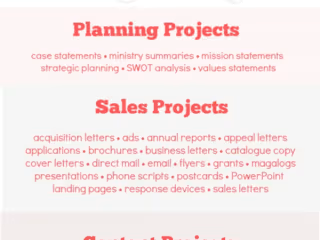Types of consulting projects
Management consultants have learned to sell all sorts of weird projects to their clients. Some of them were born out of the need of the customer. Others were developed internally by the consulting firms. Consulting projects differ drastically and I will try to shed some light on the main types of projects you can come across. There will be also plenty of examples. Btw, we have also prepared a video version of this post. You can find embedded at the end of the post.
Strategic Projects.
The first thing that comes to your mind when you think about consulting is probably the development of strategy. Not surprisingly Strategic Projects are an important source of revenue for consulting firms. However, hardly any firm needs a full strategy for the whole company. Nowadays, you would rather develop partial strategies, address certain specific areas. Below are a few examples of such projects:
Develop the strategy for supply chain/production/sourcing/sales in this type of project you have the general strategy of the firm already defined, you have some goals, capabilities and you have to suggest to the customer what would be the best way to organize the certain area. Should he do it on his own or delegate it to 3rd party? Should there be one model for everything or he should rather use a mixed model? How many facilities (warehouses, production sites, stores, etc.) he should have and where? As you can see those projects require a lot of detailed answers and they are data-driven.
Entering a new market/category of products/customer segment. In those projects, you use as the starting point what your clients already do (so there is a lot of legacy issues) and you try to adjust his strategy to a new market/category. In some cases you may have to advise him to do something totally new as adjustments will not suffice. Quite often you also have to start even earlier and help him select which markets, categories of products, and customer segments he should consider. You also have to estimate in such projects what is the potential benefit as well as connected costs. Your end-product here is a thick slide deck (100-300 slides) and plenty of models, rankings in Excel. Have a look at an example of a firm considering entering a new category of products
The strategy of transformation. In some cases the company is deep in shit, lagging behind the best practices on the market. In those cases, they call management consultants to help them decide what they should do to catch up with the main players. A great example of such projects in recent years was: building online presence especially e-commerce, digitalization, AI. Previously we had: outsourcing, centralization, decentralization, shared service centers, etc. As you can see this is always a great source of new ideas because constantly something is changing
If you want to learn more about such projects have a look at Strategy for Management Consultants and my post on how to define a strategy
Management Consultants may have started with Strategic Projects but more money is actually generated by Performance Improvements Projects. In this sort of projects you don’t have to come up with new ideas, enter new markets. You simply have to make life easier. You help the customer save money, generate higher profits, generate more cash or reduce his need for assets. Below are some examples of such projects:
Operations improvement. The main idea is to reduce costs, increase the speed & quality of the operations and reduce the inventory used by operations. Those projects require you to identify potential savings in Operations. You do that usually using lean manufacturing techniques, theory of constraints. Great project to see how the business really works and to solve real problems. In those projects, you do fewer slides, a bit more calculation, and Excels. On top of that, you create a lot of tools in Excel that should support Operations: a production planning tool, a tool for estimating the purchases, a tool for finding the best spots for locating the factory, warehouses, stores, etc. Check some examples: Where you can find savings in distribution, How to optimize processes – example, Process optimization methodology, How to decide which customer you should remove?
Cost Reduction Projects. In those projects, you concentrate on finding savings by cutting costs. You go here beyond the improvements and savings and operations and you analyze every cost position to find more money. In many cases you do the headcount reduction – in other words, you lay off plenty of people (10-30% of the overall headcount). Those projects tend to be brutal and a lot of tears are involved. The funny thing is that after some time the costs tend to go up again. So a new cut is imminent.
Pricing Projects. A lot of attention is also devoted to playing with the prices and discount policy. You try here to find the optimal prices for specific products (prices that will bring you higher gross margin, profit). You also optimize the discount policy. As a part of the projects, you may also change the price structure (add or remove new price points). This area is so big and lucrative that a lot of companies concentrate only on this area (i.e. Simone & Kucher). Check my presentation on Innovative Revenue Streams
Value Chain Improvements Projects. In the case of complicated big firms with intricate value chains, you may also go beyond the firm and look for improvements in their overall supply chain (their customers and suppliers). The main rationale for such projects is to help your partners be more efficient and share the savings
Team Efficiency Increase Projects. In many cases, you will have to increase the efficiency of a specific team. It may be Sales Team, R&D Team, Technical Support Team, etc. Those projects make sense to be done for groups of people that are expensive, big, or are bottlenecks for future growth. Here you want to make more with the same people or create a space for headcount reduction. You do it mainly using lean manufacturing techniques, theory of constraints, management consulting tools, techniques, frameworks, OLE, and other techniques. Have a look at an example of Improving Sales Force Efficiency
Automation Projects. In the western world, you have fewer working people and on top of that, there are expensive. That is why Automation Projects became so popular. The aim is very simple – get rid of people. In other words, you have to help your client find ways to replace the people with machines, tools, and software.
Liquidity Improvement Projects. In some cases, the problem is not profitability but a lack of cash. This may be due to too big an investment that has drained the company of cash, losing important customers, structural change of the market, etc. Here you want to simply find ways to generate more cash. Cost reduction helps but in most cases is not sufficient. You have to sell assets, renegotiate contracts with suppliers and customers, find new loans or renegotiate with the banks the current loans, get more equity, etc.
Below is a presentation that will help you understand Performance Improvement Projects:
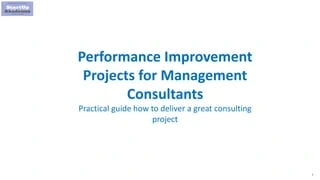


1 of 189
For more on such projects check my online course Performance Improvement Projects for Management Consultants and Cost Reduction for Managers & Management Consultants
Turn Around Projects
At some point, consulting firms decide that the market of healthy companies that need their assistance is too small. They have decided that it would be a great idea to also help a customer that is (almost) bankrupt. This is how Turn Around Projects were born. In this type of project, your client has lost profitability and most likely the liquidity and you have to improve profitability as well as the cash position. In other words, you do exactly the same things you would do during performance improvement projects but 10x faster. There is no time for subtleties, looking for small tickets. You concentrate on delivering value fast. Btw your client has a big chance of going underwater and disappearing from the face of the Earth regardless of your efforts and your great ideas. Hopefully, he will manage to pay you first
Implementation Projects
Consulting firms are a bit like tobacco. Once you start using them you get hooked. Consultants did simple math calculations and discovered that strategic and performance improvement projects are usually short 3-6 months. However, it takes their clients from 12-24 months to implement the suggested projects. This is an opportunity that they could have not missed and that is how Implementation Projects were born. In those sort of projects you help the customer deliver the ideas that you have defined on other, previous projects. Management Consulting Firms can do it in the following way:
Supervision and Assistance. This is pretty easy – you give the client usually 2-3 consultants to supervise the implementation, teach others how to do the calculations, manage projects, and explain in detail the ideas identified during strategic or performance improvement projects.
PMO. Some firms want you to provide them bigger support and ask you to create and run Project Management Office (PMO). In this situation, you have to provide both business analysts as well as project managers. This is usually done for big strategic projects – entering new big markets, turn around, moving production to a new country, etc.
Interim Management. In some cases, the assistance and supervision are not enough. You have to take responsibility for the execution, you have to provide the CEO, COO, Strategy Director, or other senior people to make the difference. This solution is usually temporary. The Interim Manager stays for 6-24 months to change the way in which the firm is run. After that, the firm hires the person that will be responsible for running a specific area.
M&A Projects
At the end of the 20th Century, we had a huge wave of mergers and acquisitions that created a lot of work for management consultants. If you are buying a company for $ 2 billion you have no problems with spending a few million to make sure that the company you buy is not worthless. Management Consultants managed to create a plethora of products to meet the needs of their customers:
M&A Strategy. You start by helping the firm define what companies they will buy and why. You usually do it via rankings and case-by-case analyses, based on the criteria define by the customers. This means that you have to gather a lot of data on potential targets. Quite often you compare the M&A option with the greenfield / organic growth – what would make more sense, what would create more value?
Due Diligence. Once you have the target identified you have to check whether it is a good enough company to be bought. The process of checking the value of the firm is called Due Diligence. Management Consulting usually performs Commercial Due Diligence (check whether the firm operates the winning model on an interesting market), Operational Due Diligence (you check how do they deliver value, run their facilities). The buyer also has to do Legal and Financial Due Diligence but this is usually done by an auditing firm (EY, PwC, KMPG, Deloitte). Check our playlist on Due Diligence
Value Creation Plan. For some buyers, you also have to create a Value Creation Plan. In other words, define how the buyer will increase the value of the firm after the transaction is finished. This sort of project is a mix of strategic and performance improvement projects.
Post-Merger Integration. Big fat corporations may also require your help after the transaction. If they want to somehow integrate the firm they have bought into their corporation they will have to do a lot of changes fast. Usually, they lack the team for that, especially if the M&A is not something that they do often. This sort of project resembles Strategic Projects at the beginning. Later you have to mainly supervise others and make sure that they deliver what they were supposed to do. Long and difficult. Afterward, take long holidays to rest from the constant pressure.
That’s in short about consulting projects. I hope you enjoyed the summary and as always I recommend trying out our online courses that will help you become Badass Management Consultants. They have been taken by more than +104 000 students, including people working in McKinsey, EY, Walmart, Booz Allen Hamilton, Alvarez & Marsal, PwC, Deloitte, Dell, Adidas, Naspers, Walgreens, Orange, Cisco, Citigroup, and many others
A few years ago I have seen a documentary movie showing a refugee camp. To my surprise they have managed to create a mini economy inside the camp. There was a school, hairdressers, church, modest fast foods and small workshops. In other words even if the worst happens a new balance is created in which the flow of goods and services carries on.
We will see the same thing during and after the coronavirus pandemic. We will be most likely witnessing pretty big recession this year and the businesses will have to adapt to the new situation. Similar to what we had after 9/11 there will be however a lot of changes in the way in which we handle human contact and how we organize our enterprises.
We have prepared a few tips on that in a form of a presentation. We have divided it into 2 parts. In the first one we provide some tips for the firms. In the second one for the governments. Some of them are short-term tips how to handle the situation 6 months. There are also tips that will help you avoid such a huge shock to the everyday life in the long run
Enjoy this presentation
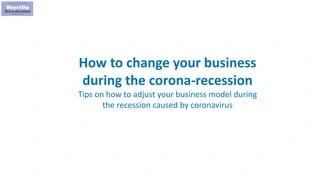


I would also recommend checking the following other resources:
Every company has to control costs in order to survive and prosper. Therefore, many firms on regular basis perform cost reduction projects. Cost reduction projects may be part of a wider Performance Improvement Project or be a standalone project carried out only in one of the business units. Those projects are extremely interesting because you will be able to make a real change, create a new reality, and improve part of the business or even the whole business. There are also very difficult as you have to not only analyze areas but also find ways to cut costs, improve the current situation as well as, on some occasions, implement the changes.
Today I will show you briefly how you can do that in practice. This will be a short introduction to cost reduction. This is a part of our course Cost Reduction for Managers & Management Consultants that I recommend checking.
We will go briefly through the main stages of cost reduction projects and I will try to provide some practical tips that should help you with projects.
So, let’s see how you can reduce, cut costs in practice.
Generate potential ideas for improvements / cost reductions
The first thing you should do before even the project starts is to create a simple framework that will help you quickly identify costs that should be eliminated or reduced.
Below a short overview of our framework for cost reduction:
As you can see we have divided the potential actions into 4 areas: Reduce usage, Automation, Process Optimization, and Renegotiation of contracts. I recommend using this framework to generate a list of potential improvements that you believe could be crucial in the business that you are optimizing.
Before the project starts you can try to guess where you can expect the biggest savings. After you get initial data you can verify your guesses with some rough estimation.
Apart from the cost reduction framework use also an issue tree. This will help you generate fast potential ideas for cost-cutting. Have a look at an example of an issue tree showing potential savings in distribution / logistics.
Identify quick wins
In the first week of the project or even before the project starts, if you have data, you should try to identify quick wins using rough estimations. This will help you prioritize analyses and find fast potential improvements with the biggest potential. This sort of analysis will also help you greatly to talk with managers, directors, and the owners of the firm. Usually, they are positively surprised once you show them potential quick wins in the first or second week of the project. This greatly increases your credibility.
In order to identify quick wins, you have to divide all potential improvements into groups. We will use the ideas for potential reductions that we have generated in the previous stage. A lot of ideas will also be generating during the first meetings with the customer. For identifying the quick wins we are using the following framework:
As you can see we use 2 dimensions to prioritize potential improvements: potential savings that we can achieve by implementing the potential improvement and difficulty level. Our quick wins are the Cow Savings – easy to implement and big improvements. As a second priority, we would consider Elephants (difficult projects that still can have a big impact on the costs).
Below an examples of a quick-wins analysis done in Excel for a drugstore chain:
As you can see, with this framework, you can find out what you should concentrate on within 1-2 days.
In some cases, you will need additional data to estimate potential savings, but they can be easily obtained via benchmarks, 1-day audits, auctions, sampling, and conversations with experts or suppliers.
Detailed Analyses Phase
Once we have clarity on what to concentrate on, we can finally get down to detailed analyses. Depending on the size of the firm and complexity of the business this will take from 1 to 6 months. In the end we should have confirmed the potential savings from the Quick-win Analyses Phase. In some cases, you will discover that you were initially too optimistic. In other cases, you may find out that you have underestimated the true potential of a cost reduction project. I would recommend having every analysis in a separate Excel file. Below examples of such analyses:
On the basis of such analyses during consulting projects, you prepare a list of potential cost reductions, improvements that can now be considered for implementation. The analyses are bases for the final presentation in which you show by how much the customer can increase EBITDA by cutting costs. The best way to show the potential savings is to do it through a waterfall chart.
When it comes to how the teams are organized, usually, you would have the responsibility for identifying and analyzing potential cost reduction spread over the whole team. The team can be organized either by areas (Sales, Supply Chain, Production, Head office), or by business units / sites.
Usually, you would have 1-2 Business Analysts analyzing 1 area or 1 business unit / site. With bigger firms you may be forced to a have mix of both methods. In this case, you would have a team of 3-4 people per site / business unit. Every person would be responsible for 1 area within 1 site.
Implementation Phase
In most cases, the project ends at the Detailed Analyses Phase. However, some customers can need support for the implementation phase. During the Implementation Phase, consultants have to switch from analytical work to project management. Below a few examples of how the support during the implementation phase can be organized
Provide full analytical and project management resources for the Implementation Phase. In this set-up, you provide Project Managers and Business Analysts that help implement the cost reductions. Usually, it would mean that around 50-70% of the initial team stays on the projects and continue the work. This obviously is extremely expensive. The consulting firm is responsible for delivering the promised cost reduction. It usually is an important part of their fee. Such projects tend to be rather long: 12-24 months.
Provide some analytical and project management resources for the Implementation Phase. In this set-up, you provide mainly Project Managers that help implement the cost reductions. Usually, it would mean that around 20-30% of the initial team stays on the projects and continue the work. The involvement is quite often also limited not only in scope but also in time. In most cases, the involvement of the consulting firm would finish after 6-9 months.
Set-up and run PMO. In some cases, you may be asked to set up a Project Management Office that will supervise the implementation of cost reduction projects. In this case, you provide the know-how, you train the people, create templates as well as procedures. However, usually, you are not responsible for delivering specific savings. In the initial phase, you may be providing 1-2 Project Managers and 2-3 Business Analysts. This tends to be much cheaper than Option 1 and Option 2. Such projects are a great source of new projects and can last years. Once you built the PMO, the benefit may be so big that they will not remove it after the cost reduction project is done.
Supervision.The most often involvement of consulting firms boils down to the supervision of the implementation. Usually, 1 Project Manager and 1 Business Analyst spend 1-2 days a week (or every second week) in the firm and check the progress. They may help with certain issues implementation teams, however, their involvement will be limited by the time that was paid by the customer.
That’s in short. Below a more extensive presentation on Cost Reduction.
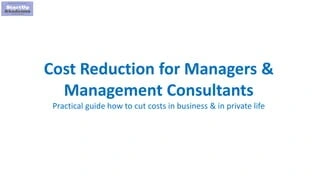
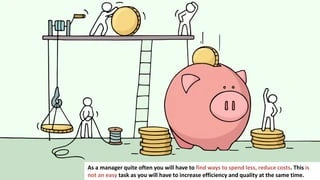

I strongly recommend checking my course Cost Reduction for Managers & Management Consultants where you can find a lot of examples of analyses done during cost reduction projects along with calculation in Excel.
Like this project
Posted Sep 29, 2023
Management consultants have learned to sell all sorts of weird projects to their clients. Some of them were born out of the need of the customer. Others were d…
Likes
0
Views
2



![Ecommerce Copywriting: 12 Tips to Boost Sales [+Examples]](https://media.contra.com/image/upload/ar_1.333,c_fill,f_avif,h_240,q_auto:good,w_320/uk7enniygp58f9nhjyxp)

